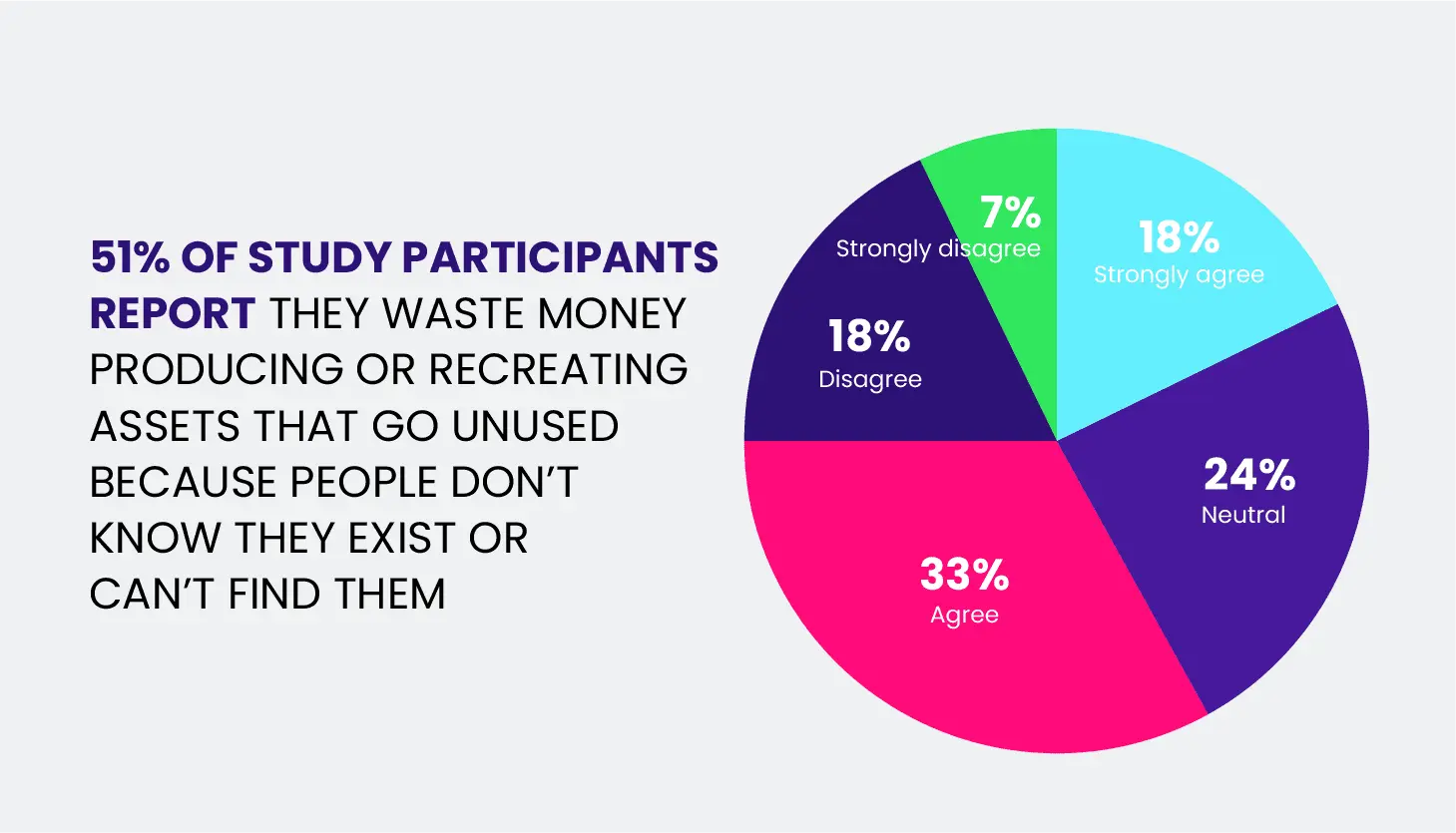In this article, you’ll learn:
Businesses need to handle content pieces efficiently throughout the year, especially during peak seasons.
Why? Organizing and categorizing digital assets can be daunting as things get busier and your focus shifts to keeping your head above water. With email and social media marketing campaigns happening left and right, keeping track of your digital assets isn’t a walk in the park.
Thankfully, artificial intelligence (AI) is here to help and has a wide range of uses.
AI-enhanced content tagging and organization systems simplify digital asset management for content creators and provide more value for the end user.
The Growing Role of AI-Powered Features in Content Organization
Since AI exploded onto the scene, it’s changed the face of many aspects of marketing. And content organization is no exception.
Traditional manual methods of categorizing and tagging content pieces are:
- Time-consuming — especially for large volumes of content pieces.
- Subjective — individuals may tag the same content topics differently based on interpretation.
- Error-prone — common errors include typographical errors, mislabeling, or overlooking relevant tags.
- Lack of standardization — a marketing team’s worst nightmare.
- Slower response to new trends — a dreaded scenario in an evolving market.
What a waste of time and money! AI helps you find what you need and when you need it.

And when you’re in the middle of a busy season (think Q4 when you are trying to hit your yearly goals), there’s no time for any mistakes.
AI content management tools will help execute marketing campaigns meticulously, pushing those sales through to conversion.
How AI-driven Tagging Systems Work
AI-driven tagging systems use algorithms to analyze content pieces and assign relevant tags. These systems can recognize patterns, identify themes, and categorize content topics based on predefined rules or machine learning models.
Some AI tagging systems use Natural Language Processing (NLP) techniques to understand the context and meaning of the content.
This enables more accurate and contextually relevant tagging and , makes it easier to search and retrieve assets later. At the same time, it provides a more friendly user experience at the front end.By incorporating AI technology, businesses can enhance various aspects of digital content such as organization and accessibility. Another important advancement is the use of AI in Text to Speech (TTS), which transforms written information into spoken language, using ultra-realistic AI-generated voices. These features are beneficial for users who require audio outputs or voiceovers for multimedia projects. Within seconds, professionals can produce natural-sounding TTS solutions that aid content creators in seamlessly integrating voice technology across multiple platforms.
AI-enhanced content tagging systems offer several benefits for businesses:
- Efficiency: With automated tagging, businesses can quickly categorize and organize hundreds of digital assets. This saves time and effort compared to manual tagging.
- Consistency: Asset categorization reduces confusion and makes locating assets for future campaigns easier.
- Improved searchability: Accurate and relevant tags enable easy search and retrieval of specific assets, even within large content libraries.
- Optimization: AI-driven tagging systems can analyze content to identify keywords and optimize assets for better discoverability and search engine rankings.
For content creators, AI-enhanced content tagging systems brings to the table the following advantages:
- Time-saving: By automating the tagging and organization process, such as offering relevant folder structures for images, content creators can focus more on the content creation process itself.
- Consistent brand identity: With consistent use of tags, maintaining brand identity and creating a seamless user experience becomes more manageable.
- Content personalization: Accurate tagging facilitates personalized content recommendations and targeted marketing campaigns, which lead to higher conversion rates.
Practical Application of AI in Content Tagging for End Users
So, what are the practical ways to put AI content tagging to use?
Create Content Categories
AI offers unique opportunities for companies like Cruise America. Specializing in RV rentals in Los Angeles, they can use AI on their blog to categorize and organize specific content that celebrates road adventures during the winter months.
This technology allows them to create a gallery of visual content perfectly aligned with the reader’s expectations of a winter RV vacation. Creating content like this enhances the appeal and relevance of their services to travelers.

The best part? The marketing team can quickly locate the latest version of the graphics for each blog post. Before sending it off to the ether, they’ll know which frosty image variation to use.
The result? Their blog readers will appreciate the organization and consistency across content.
Accessibility Improvements
AI systems can automatically generate descriptive tags and alternative text (alt-text) for visual assets like images and videos, providing context and narrative that screen readers can convey to visually impaired users. Accessibility compliance companies play a vital role in helping businesses ensure that their digital platforms are accessible to everyone, supporting compliance with legal requirements and best practices.
For instance, an AI system can analyze an image and generate a descriptive tag like “a group of people sitting around a fireplace at a coffee shop,” which screen readers can read aloud, thereby conveying the essence of the image to someone who can’t see it.
AI provides detailed descriptions of key visual elements and actions occurring in a video. This accuracy relies on data annotation, where labeled images and videos train AI to recognize scenes and actions.
Such features benefit those with cognitive disabilities by clearly and concisely explaining complex visual content.
This approach not only adheres to various web accessibility standards, such as the Web Content Accessibility Guidelines (WCAG), but also embodies a more inclusive digital environment.
Accessibility should be a serious consideration in all aspects of the content creation process, including the social media content strategy. If you’re unsure if your website or content meets these guidelines, run it through a free website accessibility checker for clarification.
Language and Translation Support
Businesses that serve global audiences need accurate translation support.
AI systems can automatically detect and tag content in multiple languages, breaking down linguistic barriers that often impede the reach and usability of digital content.
For example, an image in English can also be tagged in Spanish, Mandarin, or other languages, vastly expanding its accessibility to a broader audience.
Beyond simple translation, AI algorithms are equipped to understand and respect cultural nuances and idiomatic expressions. It ensures that tags aren’t just literal translations but culturally relevant and appropriate.
Practical Application of AI in Content Tagging for Digital Asset Managers
Now that we’ve covered the benefits for end users, let’s dive into how AI is a game-changer for digital asset managers.
Asset Recommendations
By understanding the content and context of digital asset libraries, along with the digital asset manager’s preferences and behavior patterns, AI can make highly accurate recommendations.
This feature is particularly beneficial in environments with extensive content libraries, where navigating and discovering relevant assets can be challenging.
The recommendation engine continuously learns from user interactions and refines its suggestions to become more aligned with individual user needs and interests.LLM agents can improve this process by analyzing patterns and improving recommendations in real time.
By seamlessly connecting users with the content they need or might find interesting, AI helps users find what they want quicker, which is crucial for fast turnaround times.
Successful Content Tagging Strategies
When planning to implement AI-driven content tagging for businesses, it’s important to consider the following aspects for a successful strategy.
- Define tagging guidelines: Establish clear guidelines for tag usage, to ensure consistency and relevance.
- Train AI models: Train the AI system using existing tagged data to improve the accuracy and relevance of assigned tags.
- Iterative refinement: Continuously review and refine the tagging system based on evolving content needs.
- Regular maintenance: Ensure regular tagging system updates and maintenance to adapt to changing content trends and user preferences.
- Create secure backups: Data security and preservation of digital assets is paramount. AWS backup solutions are essential for protecting the valuable digital assets for your campaigns. You can sleep well at night knowing every video, logo, and featured image is safeguarded against loss or damage.
Limitations of AI-Enhanced Content Tagging
Like everything else, auto-tagging isn’t perfect. Let’s take a look at its limitations.
- Limited by what’s in the content: AI can’t assess what’s not present in the content. Things like intent or the stage in the customer journey will still need to be added manually.
- Limited by the description of the source content: AI can’t infer what you mean - it needs specific, detailed descriptions. If descriptions lack detail, tags may not meet your expectations.
- Limited by precision and recall: A study on the auto-tagging of marketing content published in the Journal of Business Research, explained these concepts: “Precision measures how well the model avoids assigning the wrong keyword to an article; it is the number of true positives, positive instances that were classified correctly, divided by the sum of true positives and false positives (negative instances that were classified as positive). In contrast, Recall measures how well the model assigns keywords correctly to an article; it is the number of true positives divided by the sum of true positives and false negatives.”
In short, if tags lack precision, you get tags with incorrect terms. If tags lack recall, you’ll have fewer correct tags.
- Limited by its training: Depending on the training the AI receives, you can expect varied results. You may see variations in the quality of the accuracy of your tags, the completeness of your tags, and the predictability of your tags.
What Does the Future Hold for AI-Driven Content Tagging
- Sentiment considerations: AI might be able to identify and tag the sentiment of a blog post and offer a deeper layer of categorization.
- Cross-modal tagging: This is where AI systems link related content across different formats, like connecting a news article to a relevant podcast to increase content discoverability.
- Predictive tagging: AI can suggest future tags based on emerging trends and patterns, to keeping the content aligned with current and predicted user interests.
- Ethical AI: Integrating ethical AI principles will make sure that tagging is free from biases and respects privacy and data security concerns.
The whole premise and value of AI is based upon learning. Therefore, it’ll get smarter as it continuously learns from user interactions and feedback.
Wrapping Up
A surge in customer activity and content demands calls for innovative approaches in all aspects of content management. Everything from content creation to distribution and asset management must run like a well-oiled machine.
AI-driven content tagging and organization offers just that. It’s a streamlined, intelligent way to handle the content volume required to capture leads and land sales. By automating tagging, optimizing searchability, and ensuring content relevance, AI helps to save hours on end.
So, let AI handle the heavy lifting while you and your content team let your creativity shine. It’s a winning combination waiting to level up your content workflow. What are you waiting for?
Did you enjoy this article? Give Pics.io a try — or book a demo with us, and we'll be happy to answer any of your questions.




